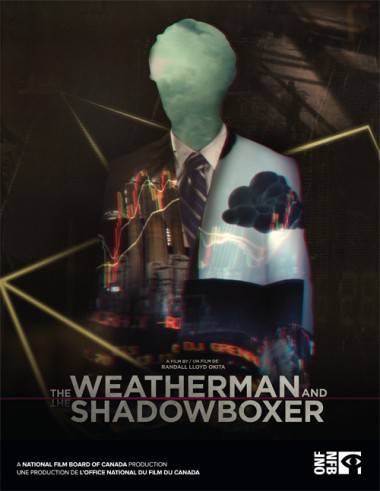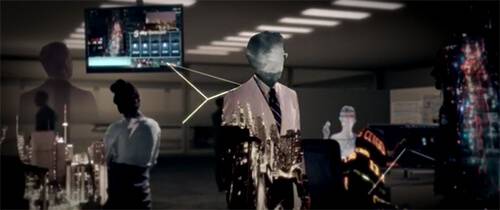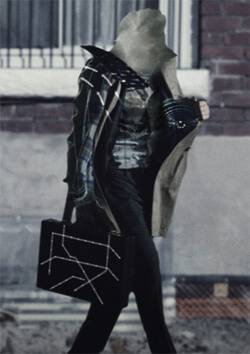Q&A with Visual Artist Randall Okita
 The latest film from Canadian visual artist Randall Lloyd Okita is The Weatherman & The Shadowboxer, a visual feast produced with the NFB which fully embraces the effectiveness of live-action/animation hybrid filmmaking.
The latest film from Canadian visual artist Randall Lloyd Okita is The Weatherman & The Shadowboxer, a visual feast produced with the NFB which fully embraces the effectiveness of live-action/animation hybrid filmmaking.
Okita’s prior work – which includes Machine With Wishbone (2008), Fish In Barrel (2009) and Portrait as a Random Act of Violence (2013) – has been met with much international acclaim, translating a variety of artistic mediums (from large-scale installations to pyrotechnics) to film. In The Weatherman & The Shadowboxer, Okita tells the story of two brothers “who were hurt when they were too young to fight back” and the vastly different lives they lead. While the Weatherman leads a life in the public eye, constantly looking to the future so as to not acknowledge their troubled past, the Shadowboxer exists as a violent semi-recluse, constantly dogged by it and seeking physical pain as a distraction from his emotional wounds.
The film’s visual execution is a work of technical excellence, with beautifully composited animation and VFX blended with live-action performances. In anticipation of its premiere at the Toronto International Film Festival this weekend we caught up with Okita to find out more.
 For the benefit of our readers can you talk a bit about your background, in particular how you gravitated toward visual art?
For the benefit of our readers can you talk a bit about your background, in particular how you gravitated toward visual art?
Well I didn’t go to film school, I fell in love with films and started volunteering on sets. I was shooing stills and then I bought a video camera and just tried my hand at things.
How did you come to work with the NFB? Was the film’s concept developed beforehand or was it more of a collaborative effort once they were on board?
I’d been kicking around this concept that I and no idea how to make happen, one of those things you dream about that is almost too ambitious to mention because it is so far fetched. Then I had the good fortune to meet legendary producer Michael Fukushima at the National Film Board of Canada. He’s the reason the film exists, he was the magician that allowed, through much mentorship and grace, the ideas to become reality, along with producer Maral Mohammadian, who took on the project in production and fearlessly fought for every idea and detail.
The visual concept and manner in which the characters and environments are composited is quite striking. Was this look something you had in mind from the outset or was it more gradually developed during production?
I’d say it’s a bit of both. I started with a lot of reference, images and video to indicate everything from looks to lighting to techniques and framing, but with a process this complex, there is always an evolution. I had great extensive conversations with live action Cinematographer Samy Inayeh and our Animation and VFX team led by Sam Javanrouh and Peter Auld, and then we dove into a process that we developed for this project.
Oftentimes within each shot there are a number of complex processes at play. Would you be able to give us a breakdown of the compositing/VFX process for the film?
Each shot is a little different. We tried everything. We designed and boarded the film, and then we shot our live-action footage on location and in green-screen studios, as well as shooting textures, everything from raindrops to smoke moving to glass breaking. After that, we started layering the images together, crudely at first, and then adding in rotoscoping and treatments and layers of graphics and animation until we found the balance between reality and the internal metaphors we were representing.

The Weatherman & The Shadowboxer (NFB/Randall Okita)
Midst all the artistry of the visuals the action is quite clear and defined. In terms of your approach to the cinematography were traditional pre-production methods used or was there room for experimentation along the way?
I used a similar system to prep the shoot that I would use with any live-action shoot, the difference being the number of shots we had to capture because many scenes were broken up into individual pieces that we combined later. There was lots of experimentation while shooting that continued well into the post-production stages with Sam and Pete.
Other successful components of the film involve its sense of atmosphere and timing – are there any particular filmmaking (or general artistic) influences you had in mind when putting the film together?
Thank you! There wasn’t any one in particular. I’d say we referenced a lot of things for one particular technique or detail, but we tried to let the film and the story develop it’s own identity as much as possible. This is a longer, harder road, but ultimately more rewarding.

The Weatherman & The Shadowboxer (NFB/Randall Okita)
Though the visual art/effects side of things is very involved, there’s a lot of live-action performance used. Do you consider this film to be animated or more live-action with strong VFX elements (or neither)? Also, is such classification important to you as a visual artist?
I call it a live-action and animation hybrid movie. I think there almost isn’t a word for the work that Sam, Pete and the team did. I think it moves beyond the traditional definitions of VFX and/or animation. The classification for me isn’t important when making the film. I think it’s good to not think about classifications or set any boundaries for yourself, and just let the story lead you somewhere honest.
Unless I’m mistaken you yourself are one of the performers in the film. Is this indicative of the story being autobiographical or is it just a matter of being fully involved in your work?
You’re right. I think any good work is autobiographical in some ways, and this movie is in many ways. For me the goal is to be as close to the centre of the work as possible, metaphorically, and in this case literally. We are dealing with silhouettes, shapes and movement – we had to shoot a performer and then remove their identity in order to create a kind of archetype, an emotional situation. I’m not an actor and it was embarrassing and difficult to stand in front of the camera despite the fact that it was just about the shapes and the movement, but it felt right to me, it felt important to push myself that way in the process of making the film, even if nobody knew.
Going through your previous work, one thing which stands out is how effectively your films are scored. What sort of relationship do you have with your composer(s)? Are you quite heavily involved or are you more inclined to have them interpret an idea and then come back to you?
Thank you for saying that! I have a treasured relationship with Menalon (composers Joseph Murray and Lodewijk Vos) who I have been lucky enough to work with on the last five films. These two illuminate and elevate the work every time. I’d say that this film has a lot about it that is hard for me to describe, but they are able to see all the weird directions that I hope to take the film and then push it even further and breathe a kind life into it. When we lock the edit and I watch the film as we develop the music is one of the few times I see the movie as an audience member, and for me, who knows the film so well, to be transported to that place is a really magical indication of the power of their work.
I’m quite interested in the charity you’re presently involved with, Presenting Our Vision. Can you talk a little bit about the purpose of the project and how it operates?
I work every year with a group of aspiring filmmakers who might not otherwise have access to the industry, and we provide a curriculum, mentorship in media making, and work placements. The purpose is to share the transformative experience of making stories and creating mentorship opportunities for those with experience to share, for those who need it.
The Weatherman & The Shadowboxer will premiere at the Toronto International Film Festival as part of Short Cuts Canada 3 this Sunday (7th) and Monday (8th). For more information visit nfb.ca and randallokita.com

